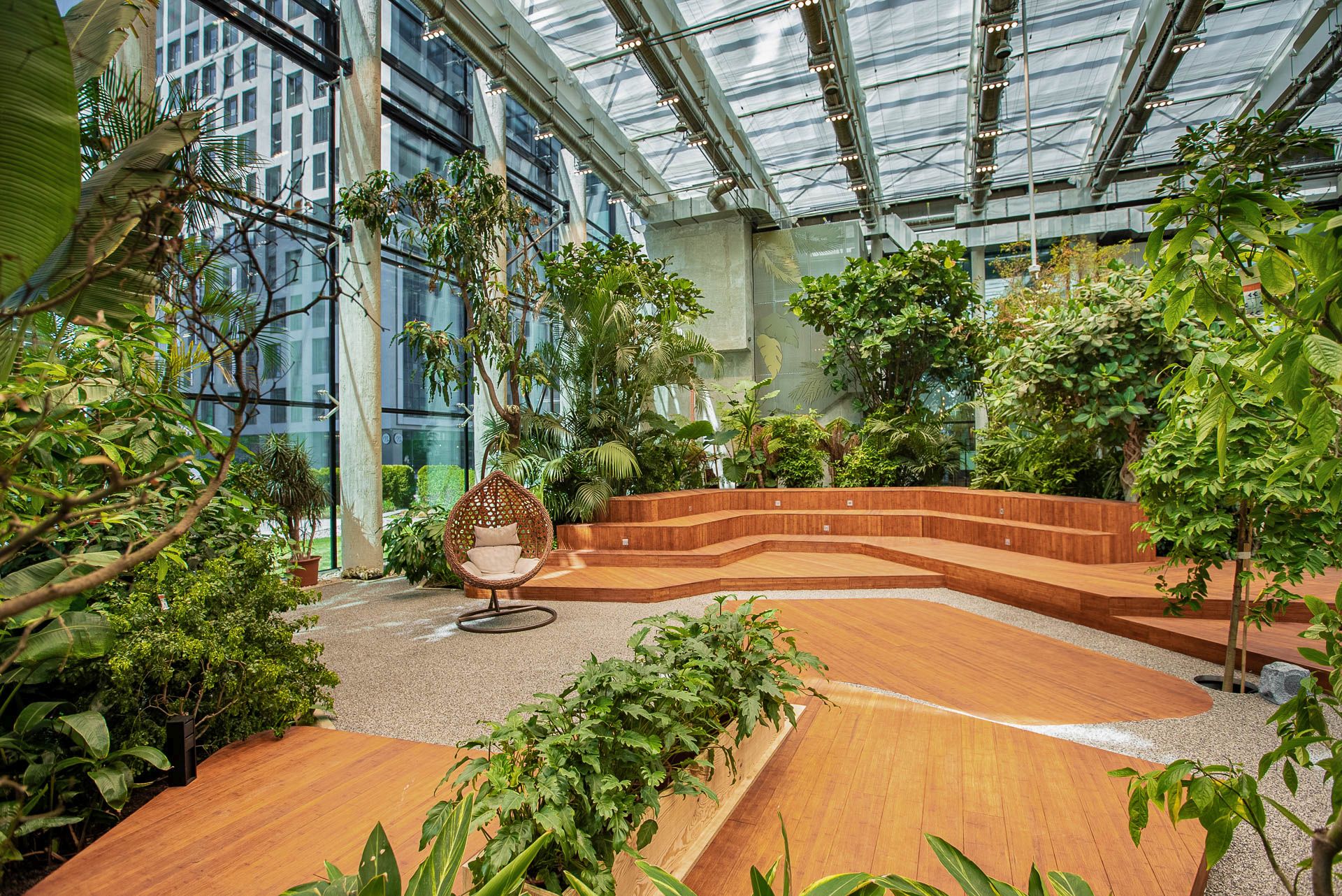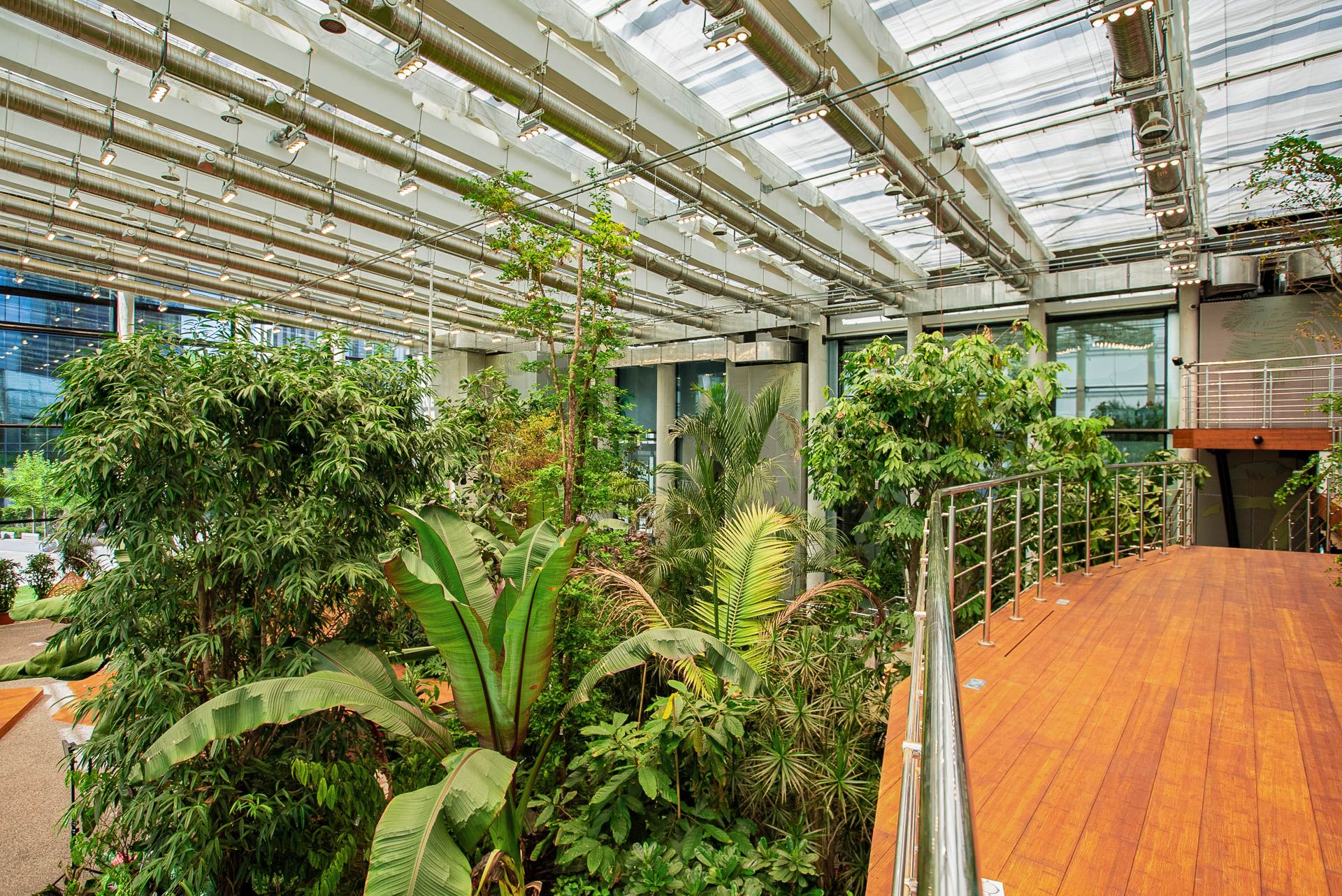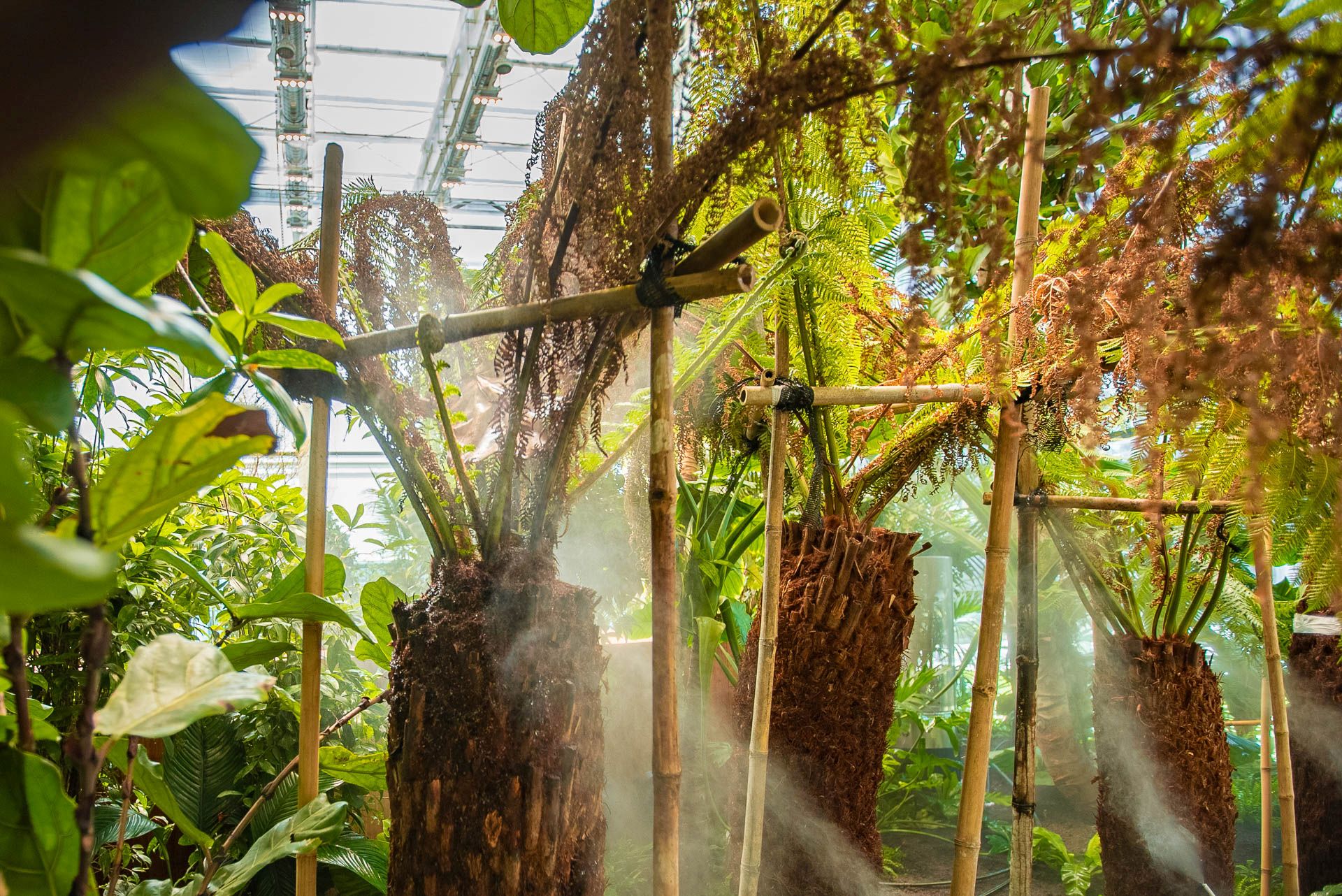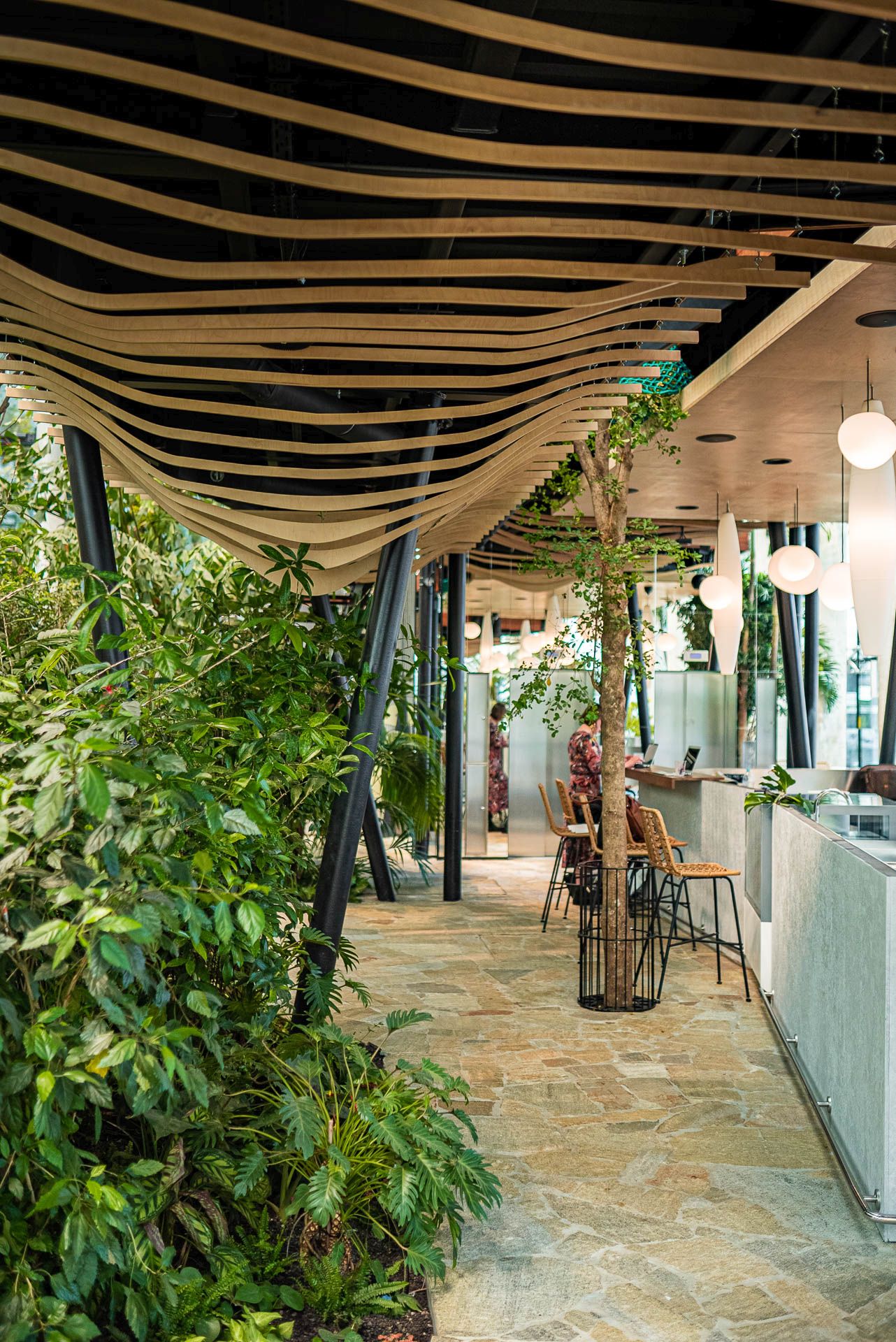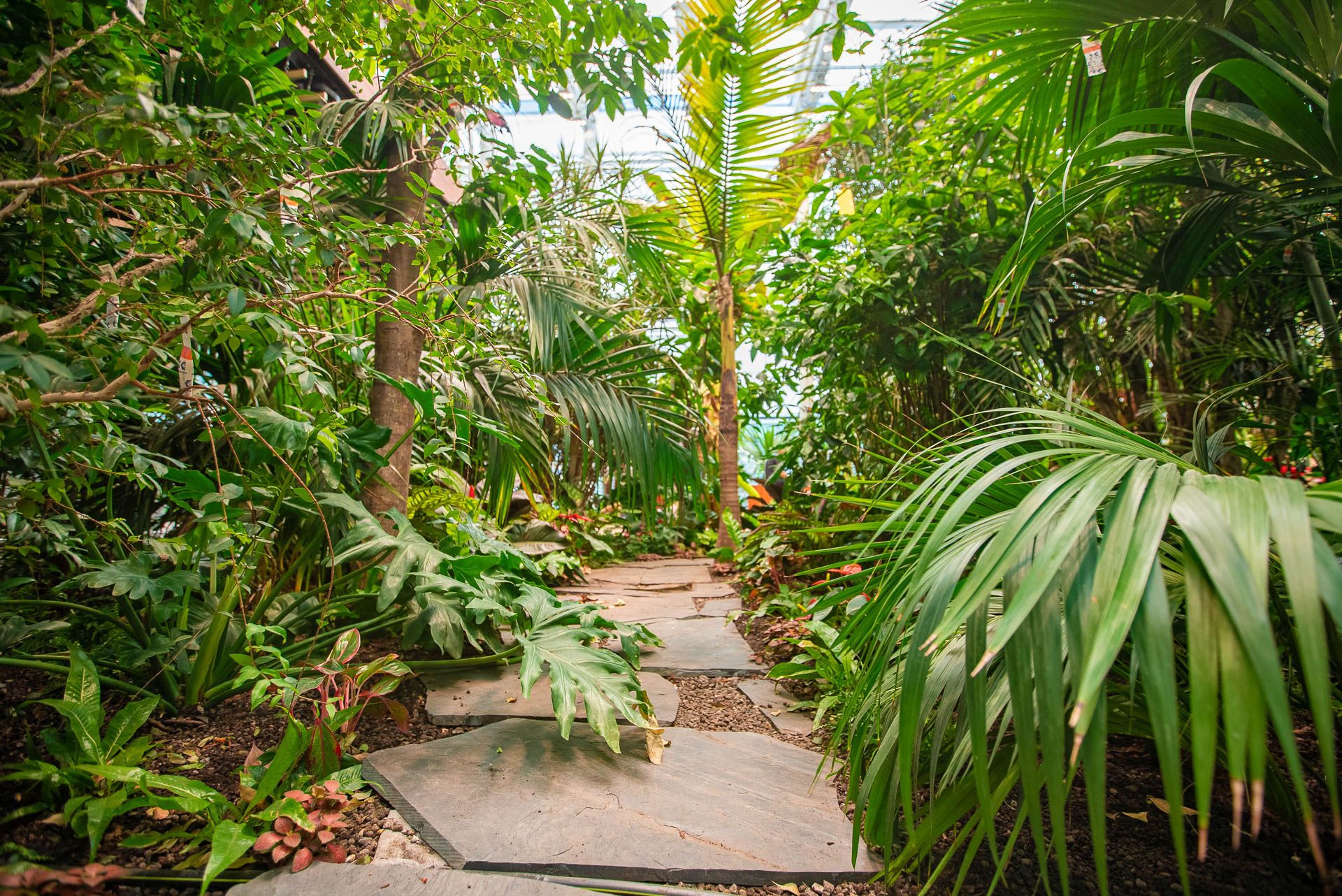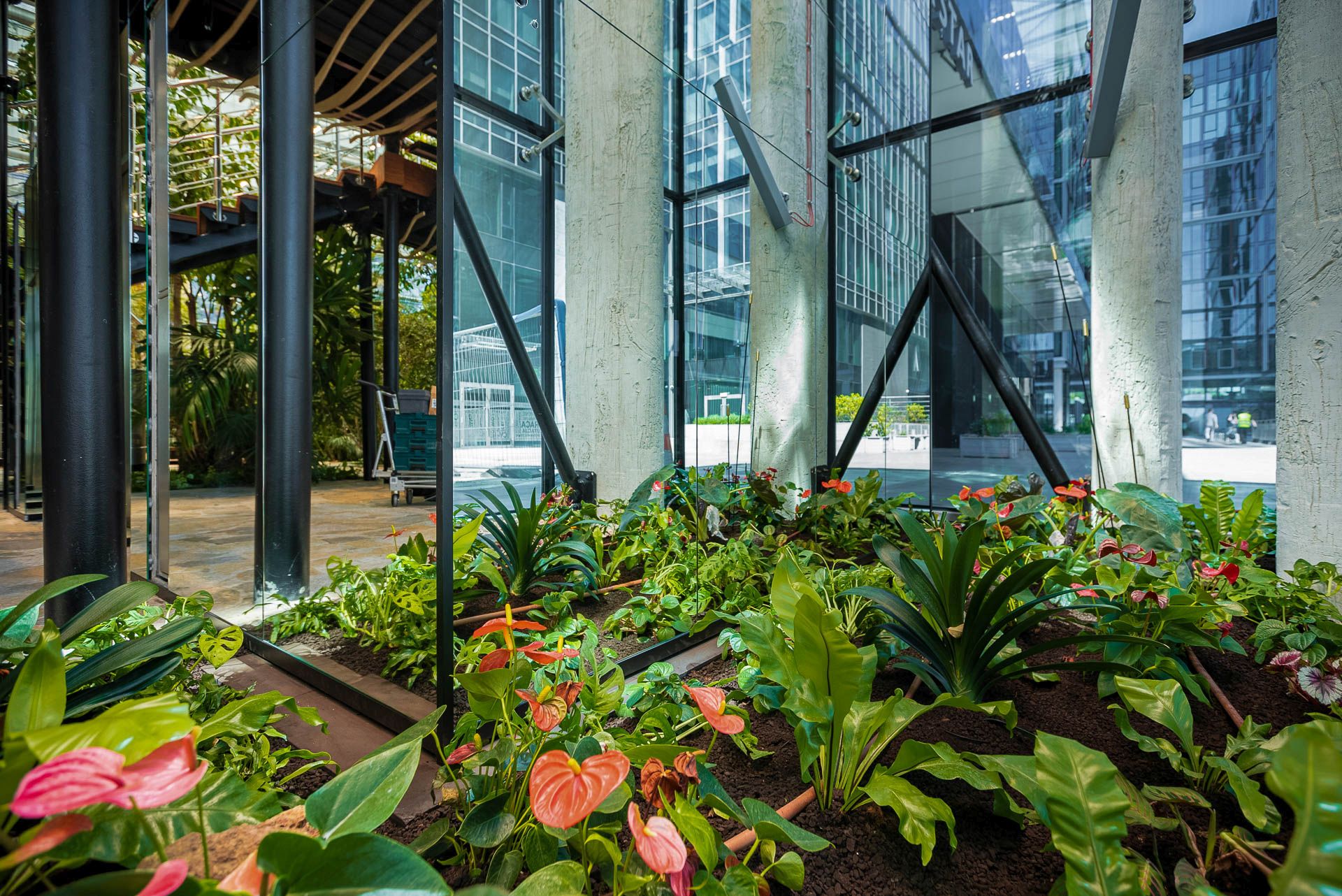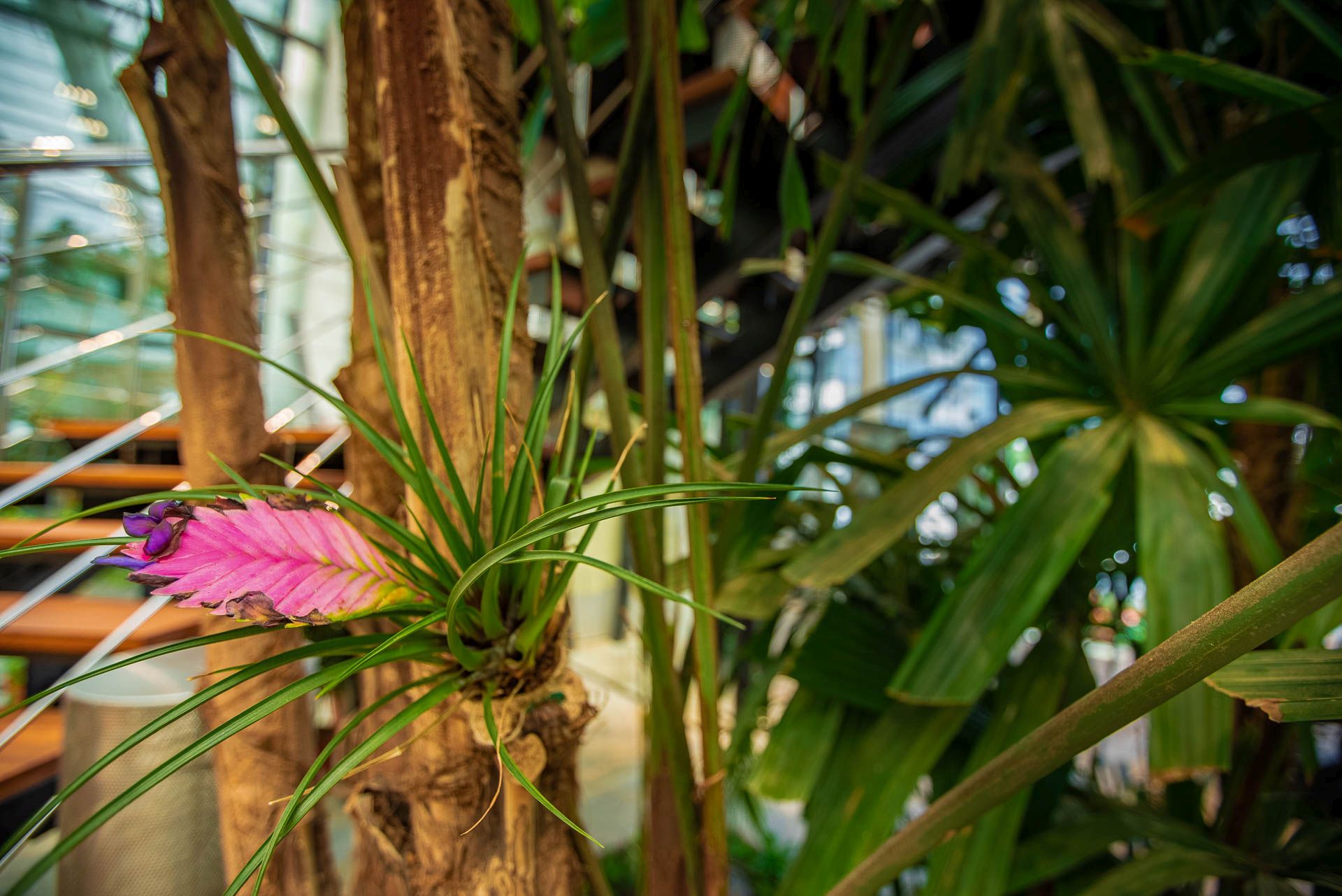The first exotic ecosystem for office spaces in Poland
In May this year, the first office investment in Poland using the Nature Connect concept was opened. The tropical ecosystem recreated by the Malinowski Design studio filled the interior of a specially built pavilion in the heart of the Olivia Business Center office complex in Gdańsk.
Nature Connect is an original concept of our design studio, which goes far beyond the previously encountered forms of interior design using living nature. Olivia Garden is a revolutionary project that combines wild nature with urban energy. Many functional areas of the office building have been integrated into the garden, which forms one of the main domains of the entire complex. During its implementation, an innovative technology for controlling the climate of the garden under the roof was used, which allows to maintain a natural, exotic garden ecosystem, even in conditions without access to daylight. Other solutions, such as office greenery arrangements or potted plants on desks and in common spaces – are usually based on a few simple plant species that can survive indoors, while at Olivia Garden, on an area of almost 800 m2, we have thousands of plants represented by over 150 species from four continents. The garden is the heart of the Olivia Business Center office complex, with an area of over 200,000 sq metres and employing nearly 12,000 people. The building is located in the business district of the Tri-City and is one of the most modern facilities in Pomerania.
What distinguishes this project from others is an uncompromising approach to create the right atmosphere for people in the space of a natural exotic garden. The result was a hybrid of Nature Connect (human-nature-technology-building), a space for work and relaxation with a year-round garden. To achieve this, we have developed a climate control technology that is innovative on a European scale. Such an equivalent of “automatic weather”, thanks to which we can control the temperature, humidity, sunlight and air exchange regardless of changing external climatic conditions, ensure the well-being of plants and the comfort of garden users. It is the only place where a person can feel like in an exotic landscape an in addition, do not feel the discomfort that often accompanies being in the tropics.
The Nature Connect concept used in Olivia Garden is based on the assumption that the arrangement of the entire space is built in such a way as to fully reflect the mood of the natural ecosystem, positively influencing the well-being of people. The design takes care of the most important details, such as noise level, air quality, type of light and an environment filled with nature, which have a soothing effect on the mood of the users. The lively, rich ecosystem of the rainforest has been recreated with great care. In order to fully ensure human contact with nature, only elements found in nature were used here. The garden is decorated with plants from Indonesia, Australia, New Guinea, Madagascar, Venezuela or tropical Amazon forests. Among them is 10m high black olive, tree fern, cocoa tree or Indian mango. They create four zones for garden users: dialogue, relaxation, coworking, food & drink. A mezzanine, terraces, paths and ramps were built between them.
This project is a summary of over 22 years of experience in designing botanical gardens, zoos, palm houses and terrariums. On their basis, we are able to move the user to the places he would like to visit, giving him the opportunity to fully interact with nature in such an unnatural environment as an office and a city. Olivia Garden is the first step towards finding solutions that will help us better understand the relationship between human comfort and nature. By introducing “nature connect infrastructure” to buildings, we create a relaxed atmosphere, bond with nature, which has a positive effect on the level of commitment, creativity and interaction between people.
At the heart of the Olivia Garden project is a natural need for contact with nature, which is difficult to ensure, especially in the city. Thanks to the technology and experience of Malinowski Design, similar installations can faithfully reflect almost any part of tropical ecosystems, with full climate control and with care for the well-being of people using this type of space. It does not have to be a greenhouse or a pavilion, but it can be any space, even the difficult and unwanted one, where there is a chance for a little peace and a place that will be vibrant and energetic. The priority for the creators of Olivia Garden was to create conditions, in which people will be able to commune with nature in all its richness and vitality. For this reason, the entire composition consists not only of lush vegetation, but also a number of other elements that we could encounter, for example, in a rainforest. Fallen trees overgrown with moss, streams of water meandering between plants, or rocks entwined with tree roots, reflect the natural environment. This effect is the result of cooperation between landscape architects, botanists and technologists in the field of climate production, using the latest solutions, sculptors and interior designers.
The Nature Connect formula is an open project, each time precisely adapted to the investor’s expectations and the building’s capabilities. Each installation of this type is characterized by its own dynamics and the created ecosystem, although under control, actually lives – it is not only a static wall of plants or an arrangement in pots.
The choice of technology and the garden arrangement itself had a huge impact on reducing energy consumption. This is due to the fact that we have a rich composition of plants that capture a significant part of the energy through the leaves. Plants also cast a shadow on the floor, which prevents it from heating up from the sun. Appropriate arrangement of plants in the pavilion forces the natural air movement, which contributes to the increase of perceptible comfort for humans. At the same time, due to the convection movement of the ventilation devices, energy expenditure is reduced. In addition to controlling sunlight, the shading curtains additionally fulfill the function of thermal insulation, reducing costs for cooling and in winter they limit heat loss. The system alternately regulates humidity and noticeably lowers the temperature, which is necessary to create a climate for plants and people. The object, thanks to its structure and high inertia, uses these weaknesses as an advantage. When the outside temperature drops, the inside humidity increases, which is beneficial for the plants and supports the fertilization process, which reduces the cost of energy needed for drying. Thanks to plants, energy costs are reduced and the climate is friendlier for humans. The irrigation and fertilization is a modern, fully automated nutrient system, where nutrients in the form of diluted mineral salts are supplied in a proper form to the plants. Thanks to the recirculation system, water losses are minimal – practically as much is lost as evaporated through open windows and the water for cultivation itself is collected from the rain.
Olivia Garden Milestones
2016 – Malinowski Design wins the Olivia Business Center competitionThe inspiration for our competition project “Olivia archipelago” were tropical islands and a combination of a secret garden with a technological jungle.2017 – delivery of the concept – garden variants in the pavilion
2018 – start of work on the technical designWe hired experts in the field of plant cultivation and breeding, greenhouse technology, aquarists, lighting technicians and sound installers.Two years before the scheduled planting date, we selected trees during a visit to a Dutch forest nursery.
2019 – preparation for the implementation of the garden design, we are testing the design on prototypes during workshops with future users of the garden.
Spring 2020 – start of garden construction, installation of systems – shading curtains, fogging system and ventilation, lighting to feed plants, construction of platforms, mezzanines, plant growing system.
February 2021 – the first trees arrive
May 2021 – opening of the garden
[easingslider id=”2834″]The designed greenery at Olivia Garden consists of nearly 4,000 plants, including 118 species and varieties. To make the green space of the pavilion more attractive, it has been divided into three zones: dry, wet and floodplain, characterized by different plant species and the type of specially prepared substrate, matched to the requirements of individual species. The skeleton of the composition is made of tall trees and palm trees. Under their canopy there is a layer of undergrowth represented by smaller specimens of trees and shrubs. They build the spherical space of the pavilion, dividing it into smaller zones. The plants used come from equatorial, tropical and subtropical regions with a humid climate. The natural habitats of the plants used in the project are mainly Central and South America, wet forests of Madagascar, Africa, South Asia, southern Japan and wet regions of Australia. Among the most interesting species in the pavilion are:
Averrhoa Carambola / Common Osmian (carambola)
Tropical evergreen tree with a height of 7-10 m, found naturally in Malaysia and Indonesia on the island of Java. They can also be found in Oceania, South America (Brazil, Guyana) and North America (Florida, Hawaii). The fruit in the form of a yellowish berry with an elongated shape and five oblong ribs. After cutting, the characteristic star shape is visible.
Ficus alli / narrow-leaved ficus
A tree with long, dark green, pointed leaves. This plant is native to the tropical forests of Southeast Asia. Our specimen is unique because it grew in a container at a tree nursery in Florida. The region is known for frequent hurricanes. After passing one of them, there is a distorted trunk of the ficus and the remains of the container in which it initially grew.
Pandanus utilis / pandan persistent
A branchy evergreen tree, native to the wet forests of eastern Madagascar, with numerous stilt adventitious roots. Long, strong and durable fibers are obtained from the leaves, used for braids, hats, bags and baskets. Fibrous roots used in making brushes.
Ravenala madagascariensis / Madagascar pielgrzan
A species of tropical perennial, growing up to 20 m. It comes from Madagascar, but is sometimes planted as an ornamental plant in many countries with tropical climates. The trunk ends with a fan of very large leaves arranged in one plane. The popular name “Traveler Tree” comes from the stories of thirsty travelers who quench their thirst with water accumulated in the leaf sheaths of the plant. Up to 1.5 l of water can be obtained from the leaf sheaths of a single plant. Large, creamy-white flowers are pollinated by bats and lemurs searching for nectar.
Alocasia macrorrhizos / giant alocasia
A species of plant from the picture family – producing an inflorescence in the form of a bulb, surrounded by a leaf. It comes from the areas of tropical Asia (Malaysia) and Australia (north-east coast). A plant with a thickened stem growing up to 5 m in height and 25 cm thick. Characteristic large leaves only grow at the top of the stem. They have a plate up to 60 cm long growing on a petiole up to 100 cm long.
Cananga odorata / jagodlin wonny/ylang-ylang
It occurs naturally in Southeast Asia and Northeast Australia. In Malaysia, the plant is commonly called ylang-ylang and this name is also transferred to the aromatic oil made from flowers of this species, which is an ingredient of, among others, Chanel No. 5. Pendulous flowers, gathered in clusters, develop in the leaf axils. Flowers green in color, later turning yellow.
Plinia cauliflora / jabuticaba edible
A species native to South America, found in the wet forests of the Atlantic coast of the south-eastern Brazil. White and yellow flowers growing directly on the trunk and branches (kaulifloria) in clusters of four. Black fruit, sweet, white, transparent flesh, similar to grapes.
Theobroma cacao / proper cocoa
The plant comes from the humid tropical forests of South and Central America, and is also widely used in cultivation, among others in Africa. An evergreen tree with a compact crown and a height of 10-15 m or a shrub up to 5 m in height. It has a thin, cinnamon-brown bark. Flowers from pink to red, set on short stalks growing in bunches directly from the trunk and branches (kaulifloria). The fruit is large, shaped like a football. The fruit contains 20 to 60 cocoa beans covered with a thick yellow-orange shell.
Dicksonia antarctica / Antarctic Diksonia
One of the few representatives of tree ferns in the world. This species is native to the tropical and subtropical forests of New Zealand and Australia. The characteristic ‘trunk’ is a woody fern rhizome growing vertically, on which small roots are often visible. At the top of the rhizome there is an extensive leaf plume, the diameter of which may be approx. 4 m.
Cycas revoluta / sagowiec bent
A long-lived species naturally occurring in southern Japan, a popular indoor and ornamental plant grown in countries with mild, warm climates. The plant is characterized by very slow growth – 1-2 leaves per year. The specimens present in the pavilion are old specimens over 2.5 m high, but also smaller, forming small groups of varying heights. HeliconiaPerennial related to the banana tree, characterized by the presence of a rhizome. A species with characteristic inflorescences in strong colors of red and orange, often juxtaposed with each other. Various species and varieties have upright or hanging inflorescences, pollinated by hummingbirds and bats.
Mangifera indica / Indian mango
It comes from the areas of India, Malaysia, China and the Philippines. It is cultivated in regions with a climate similar to a tropical climate. Mango trees are long-lived, reaching 300 years or more. Both, the flowers and the inflorescences develop gradually. The flowering period is 20–40 days. Mango flowers are wind-pollinated, but insects play an important role in pollination. Mangoes usually bloom once a year. Aromatic fruit – drupes up to 15 – 20 cm long. 55% of the fruit is flesh, the rest is seed. Mango is India’s most important fruit. It accounts for half of the production.
[easingslider id=”2835″]PROJECT: MALINOWSKI DESIGN URBAN & LANDSCAPE
FUNCTION: exotic garden at workplace
INVESTOR: Olivia Business Centre
PROJECT LAUNCH YEAR: 2018
CONSTRUCTION: 2016-2021
PROJECT TEAM: Dariusz Malinowski, Daniel Konopka, Beniamin Straszewski, Tomasz Kurtek, Jakub Woźny
BOTANICAL CONSULTANCY: Joanna Bogdanowicz
BUILDING PROJECT: BJK Architekci
CONSTRUCTION: Skills Group Dariusz Czeplina
AQUARISTICS: Jakub Kordas
LIGHTNING: QLAB Laboratory of Light
SOUND SYSTEM: Mood Media
INSTALLATIONS: Sanis
TECHNOLOGY: Green Drop Tomasz Pogorzelec

